Suitable trees for small gardens
Pride of India, Crepe Myrtle, Trots van Indie - Lagerstroemia indica
Salvia, Sage - Salvia
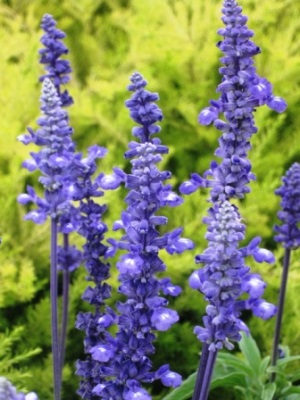 Salvia 'Victoria' Picture courtesy www.steyns-nursery.co.zaCondensed Version:
Salvia 'Victoria' Picture courtesy www.steyns-nursery.co.zaCondensed Version:
There are hundreds of different types of salvias available to gardeners, and they all have beautiful tall flower spikes, and attractive green or grey-green leaves which are often aromatic. They will flower almost all summer and autumn, and new selections come out almost every season, which are valued for their extended blooming season and spires of dense or loose flowers in shades of red and pink, or bright blue, violet, cream and white. Tall and dwarf varieties are available, varying in height and spread from +-15 to 90cm tall.
Although the summer flowering annual salvias (Salvia splendens) are well known and loved by gardeners, perennial salvias have become mainstays of the summer garden, providing season long colour at very little expense. The taller varieties of sage will add accent to flowerbeds and the dwarf varieties make excellent border plants and work well in containers, mixed with other summer flowering annuals. Butterflies as well as nectar eating birds are drawn like magnets to salvias.
Salvias do well in most of our growing regions and perform extremely well in hot gardens. Although they are drought tolerant, to look at their best they should be watered moderately during long hot and dry spells. They thrive in full sun but will take light shade; and in regions which experience extremely hot weather, the plants will appreciate some shade during the hottest time of the day.
Although there are salvias suitable for almost all climates, take care when choosing them because not all salvias are hardy in all regions, and extreme frost is fatal to them. Moderate frost may damage them but they usually recover quickly with the onset of warmer weather. For this reason, with the exception of those frost-free and humid regions, salvias are often grown as summer annuals.
Salvias grow well in sandy loam soils with perfect drainage, but will adapt to most garden soils, but it is vital that the soil drains well to prevent root rot. Salvias are not hungry plants and overly fertile soils, or too much fertiliser will actually reduce flowering, so feed only once a season in spring, and mulch the roots with fresh compost. If you cut back your plants back lightly after each flush of flowers, new growth will soon emerge, and your plants will bloom almost continually. Just before winter sets in is the best time to prune them back sharply and to renew the organic mulch around their root systems if you want to protect them from the cold.
Mexican Bush Sage, Velvet Sage (Salvia leucantha)
Mexican Bush Sage is a spreading shrub with soft, narrow, wrinkled leaves that are pale green on top and woolly and silver-white underneath. In spring long sprays of white flowers appear, contrasting beautifully with the velvety purple calyces. This salvia blooms abundantly in spring, intermittently in summer, and then again with renewed vigour in autumn. Use Mexican bush sage in mixed borders along with rosemary, buddleia, and other salvias like blue anise sage or autumn sage.
Autumn Sage, Cherry Sage (Salvia greggii hybrids)
Autumn Sage is a highly variable plant, with numerous named cultivars, and varying in height from +-30cm to 1.22m, and less in width. Its growth habit can be either upright or mounding; and it’s mid-green leaves have a minty fragrance. Contrary to its common name, it blooms throughout the summer and autumn, until the first frosts. Flower size and colour range have been enhanced by breeding, resulting in many cultivars which include many shades of scarlet and red, which is the most common colour found in the wild; as well as rose, pink, salmon, lavender, pale yellow, apricot, violet and white. Autumn sage is a popular water-wise plant for hot, dry areas because it blooms for so long and is delightful to use as a small, ornamental, flowering shrub in a perennial bed or even as a low hedge.
Mealy Blue Sage, Mealy Sage, Mealycup Sage, Blue Sage (Salvia farinacea)
There are several garden cultivars of Mealy Sage that differ in size and flower colour. Cultivars vary in size from +-30cm to 1.2m tall.
Blue Salvia 'Victoria' (Salvia farinacea)
'Victoria' produces beautifully showy deep blue flowers from spring until autumn if the dying flowers are kept trimmed off.
Salvia Mystic 'Spires Blue' (Salvia longispicata x farinacea)
'Spires Blue' blooms from spring all the way through to autumn; and the dark grey-green leaves are a perfect foil for the showy purple-blue flowers.
Anise Sage 'Black and Blue' (Salvia guaranitica)
'Black and Blue' has startlingly bright, cobalt-blue flower spikes which are framed by black calyces and stems; appearing from mid-summer and continuing deep into autumn. This salvia is a wonderful background plant, creating a brilliant display in landscapes and flower borders.
Pineapple Sage, Pynappelsalie (Salvia elegans)
Pineapple Sage is spectacular when in full bloom with its masses of tubular, blood red flower spikes that contrast perfectly against the bright green leaves. The leaves have a wonderful fresh pineapple scent when crushed. Mass plantings of Pineapple Sage will create a striking splash of colour, but even single specimens look great in the shrub or perennial border. It also grows well in larger pots if it is clipped regularly and the soil is very well drained.
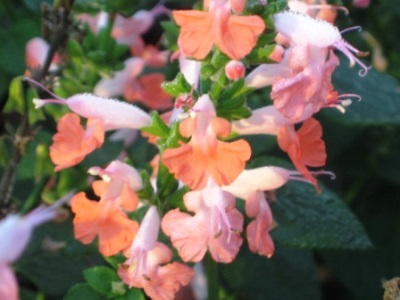 Salvia greggii 'Coral' Picture courtesy www.steyns-nursery.co.zaFull Version:
Salvia greggii 'Coral' Picture courtesy www.steyns-nursery.co.zaFull Version:
Description, History & Interesting Facts:
Salvia is commonly referred to as sage, and is the largest genus in the mint family (Lamiaceae); and includes annuals, perennials and soft-wooded evergreen shrubs; as well as culinary and medicinal herbs and garden ornamentals. The genus has approximately 900 species and is distributed throughout the Old World and the Americas, with three distinct regions of diversity: Central and South America has about 500 species; Central Asia and the Mediterranean 250 species, and Eastern Asia with about 90 species. More than half of the species of Salvia are native to the Americas, occurring in a wide range of habitats, from coastal to alpine. There are hundreds of different types of salvias available to gardeners, and they all have beautiful tall flower spikes, and attractive green or grey-green leaves which are often aromatic. They will flower almost all summer and autumn, and new selections come out almost every season, which are valued for their extended blooming season and spires of dense or loose flowers in shades of red and pink, or bright blue, violet, cream and white. Tall and dwarf varieties are available, varying in height and spread from +-15 to 90cm tall. Although the summer flowering annual salvias (Salvia splendens) are well known and loved by gardeners, perennial salvias have become mainstays of the summer garden, providing season long colour at very little expense. The taller varieties of sage will add accent to flowerbeds and the dwarf varieties make excellent border plants and work well in containers, mixed with other summer flowering annuals. Butterflies as well as nectar eating birds are drawn like magnets to salvias.
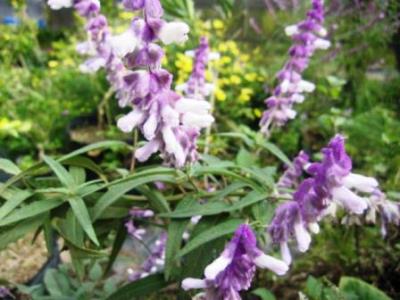 Salvia leucantha. Picture courtesy www.steyns-nursery.co.zaMexican Bush Sage, Velvet Sage (Salvia leucantha)
Salvia leucantha. Picture courtesy www.steyns-nursery.co.zaMexican Bush Sage, Velvet Sage (Salvia leucantha)
Mexican Bush Sage is a semi-evergreen herbaceous perennial which is native to Central America and Mexico. It is a spreading shrub with soft, narrow, wrinkled leaves that are pale green on top and woolly and silver-white underneath. In early winter it becomes totally deciduous for a few months, but new growth appears again in midwinter. In spring, long sprays of white flowers appear, contrasting beautifully with the velvety purple calyces. This salvia blooms abundantly in spring, intermittently in summer, and then again with renewed vigour in autumn.
Use Mexican bush sage in mixed borders along with rosemary, buddleia, and other salvias like blue anise sage or autumn sage. The flowers of this sage can also be used as a cut-flower and the flowers are very long lasting. Its soft greyish foliage is attractive all summer long as an accent to the other shrubs that are blooming; then in the autumn when most of the other shrubs are getting tired, Mexican bush sage comes into its own.
This sage thrives in hot and dry Mediterranean and subtropical gardens; performing well in sandy soils, and tolerating periods of drought with ease. Although it is considered tender to frost it will take light frost if planted in a protected place in the garden. It loves full sun but will take some shade, and generally grows +-1m tall and 1m wide, but can reach 1.3m tall with a 2m spread if left unpruned. Although this plant tolerates some drought, it will look at its best in the garden if watered moderately during very dry, hot spells. As it flowers, the plant spreads outward and is subject to fall over and break off stems. Remove flower clusters as they age to reduce the weight on the stems. The best time to cut it back into shape would be right after it has finished blooming in autumn and before it becomes dormant in winter, but it can also be pruned in early summer.
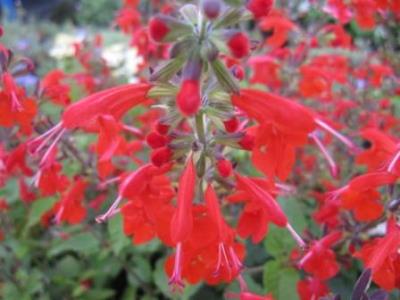 Salvia 'Lady in Red' Picture courtesy www.steyns-nursery.co.zaAutumn Sage, Cherry Sage (Salvia greggii hybrids)
Salvia 'Lady in Red' Picture courtesy www.steyns-nursery.co.zaAutumn Sage, Cherry Sage (Salvia greggii hybrids)
Autumn Sage is an evergreen herbaceous perennial which is native to a long, narrow area from southwest Texas, through the Chihuahuan Desert and into the Mexican state of San Luis Potosi, typically growing in rocky soils at elevations from 1,500 to 2,700m. This salvia is a highly variable plant, with numerous named cultivars, and varying in height from +-30cm to 1.2m, and less in width. Its growth habit can be either upright or mounding; and it’s mid-green leaves have a minty fragrance.
Contrary to its common name, it blooms throughout the summer and autumn, until the first frosts. Flower size and colour range have been enhanced by breeding, resulting in many cultivars which include many shades of scarlet and red, which is the most common colour found in the wild; as well as rose, pink, salmon, lavender, pale yellow, apricot, violet and white.
Autumn sage is a popular water-wise plant for hot, dry areas because it blooms for so long, and is delightful to use as a small, ornamental, flowering shrub in a perennial bed or even as a low hedge. It is valued for its adaptability to most garden soils and its tolerance to moderate frost, as long as the roots are mulched in winter and it is planted in a protected position in the garden.
(Salvia greggii 'Hot Lips')
'Hot Lips' has two-toned red and white flowers, and grows approximately 50cm tall and 50cm wide..
(Salvia greggii 'Neon Pink')
'Neon Pink' has bright pink flowers, and grows approximately 50cm tall and 50cm wide.
(Salvia greggii 'Red Surprise')
'Red Surprise' had cerise-pink flowers, and grows approximately 50cm tall and 50cm wide.
(Salvia greggii 'Sierra Pink')
'Sierra Pink' has pink flowers, and grows approximately 50cm tall and 50cm wide.
(Salvia greggii 'Salmon Smoothy')
'Salmon Smoothy' has soft salmon-pink flowers, and grows approximately 50cm tall and 50cm wide.
(Salvia greggii 'Sweet Lips')
'Sweet Lips' has pink flowers, and grows approximately 50cm tall and 50cm wide.
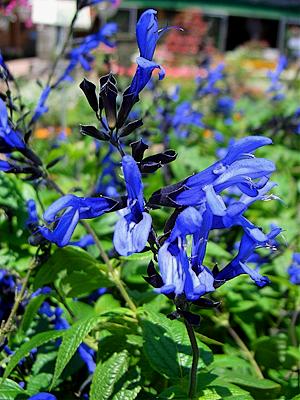 Salvia guaranitica 'Black and 'Blue'Mealy Blue Sage, Mealy Sage, Mealycup Sage, Blue Sage (Salvia farinacea)
Salvia guaranitica 'Black and 'Blue'Mealy Blue Sage, Mealy Sage, Mealycup Sage, Blue Sage (Salvia farinacea)
Salvia farinacea is a much branched perennial herb native to Mexico, New Mexico and Texas. There are several garden cultivars that differ in size and flower colour. Cultivars can be as small as +-30cm to as tall as 1.2m.
Blue Sage 'Victoria' (Salvia farinacea)
'Victoria' is a small evergreen perennial with long green leaves, which may, or may not have teeth. It produces beautifully showy deep blue flowers on +-50 to 60cm tall spikes, and +-30 to 40cm wide plants. This salvia will bloom from spring until autumn if the dying flowers are kept trimmed off. It is hardy to moderate frost but is grown as an annual in very cold regions.
Salvia Mystic 'Spires Blue' (Salvia longispicata x farinacea)
'Spires Blue' is a small evergreen perennial with a compact, upright growth habit. It blooms from spring all the way through to autumn; and the dark grey-green leaves are a perfect foil for the showy purple-blue flowers. This sage grows +-40cm tall and +-30cm wide, and is hardy to moderate frost.
Anise Sage 'Black and Blue' (Salvia guaranitica)
'Spires Blue' is a lovely evergreen perennial which is native to Brazil, Paraguay and northern Argentina. It has an open habit, growing about 1 to 1.5m tall and can spread as wide; and the common name anise sage refers to the sweetly scented leaves, which release their aroma with even the slightest touch. The startlingly bright, cobalt-blue flower spikes are framed by black calyces and stems; and appear from mid-summer and continue deep into autumn.
This salvia is a wonderful background plant, creating a brilliant display in landscapes and flower borders. It is easily cultivated as a summer annual and is hardy to moderate frost, as long as the roots are mulched in winter and it is planted in a protected position in the garden.
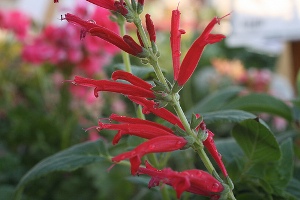 Pineapple SagePineapple Sage, Pynappelsalie (Salvia elegans)
Pineapple SagePineapple Sage, Pynappelsalie (Salvia elegans)
Pineapple Sage is a perennial shrub that is native to the highlands of Mexico and Guatemala. In late summer when it is in full bloom it is simply spectacular, with its masses of tubular, blood red flower spikes that contrast perfectly against the bright green leaves. The leaves have a wonderful fresh pineapple scent when crushed.
It is also known for its healing properties and its name means 'to save or heal'. Its fragrant, pineapple flavoured leaves and edible flowers are added to fruit salads, cakes, vinegars and herb butters. Pineapple Sage is delicious if used with Citrus fruits and is included in fruit or wine cocktails. It is also excellent with fatty meats like pork, pasta, stuffing, gravies, stocks and cheese sauces.
Mass plantings of Pineapple Sage will create a striking splash of colour, but even single specimens look great in the shrub or perennial border. It also grows well in larger pots if it is clipped regularly and the soil is very well drained.
Pineapple sage is an evergreen perennial plant that is tender to frost, but will tolerate moderate frost if planted in a protected position in the garden. In severe frost regions it will die down completely in winter and grow back the following spring, as long as the roots are mulched in winter to keep the soil from freezing. It loves full sun and grows best in fairly rich, light, dry, well drained alkaline soil, but will adapt to most garden soils with good drainage. It grows +-90cm tall and 1m wide.
Read more about pineapple and culinary sage (Salvia officinalis) in our herb section.
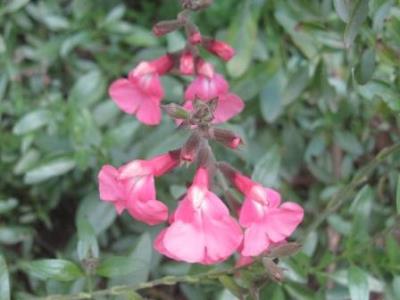 Salvia greggii 'Coral Pink' Picture courtesy www.steyns-nursery.co.zaCultivation:
Salvia greggii 'Coral Pink' Picture courtesy www.steyns-nursery.co.zaCultivation:
Salvias do well in most of our growing regions and perform extremely well in hot gardens. Although they are drought tolerant, to look at their best they should be watered moderately during long hot and dry spells. They thrive in full sun but will take light shade; and in regions which experience extremely hot weather, the plants will appreciate some shade during the hottest time of the day.
Although there are salvias suitable for almost all climates, take care when choosing them because not all salvias are hardy in all regions, and extreme frost is fatal to them. Moderate frost may damage them but they usually recover quickly with the onset of warmer weather, as long as they are planted in a protected position in the garden and their roots are mulched in winter. For this reason, with the exception of those frost-free and humid regions, salvias are often grown as summer annuals.
Salvias can usually tolerate brackish (salty) water and grow well in sandy loam soils with perfect drainage, but will adapt to most garden soils, but it is vital that the soil drains well to prevent root rot. For this reason they are difficult to cultivate in heavy clay soils.
Salvias are not hungry plants and overly fertile soils, or too much fertiliser will actually reduce flowering, so feed only once a season in spring, and mulch the roots with fresh compost; this will be sufficient fertilisation to see your plants through the season.
If you cut back your plants back lightly after each flush of flowers, new growth will soon emerge, and your plants will bloom almost continually. Just before winter sets in is the best time to prune them back sharply and to renew the organic mulch around their root systems if you want to protect them from the cold.
Propagation:
Annual salvia's are very easy-to-grow and can be sown directly into well-prepared garden beds or seedling trays in spring and summer. Cuttings also root easily and can even be rooted in water.
Perennial salvias set seed readily and sometimes surprises occur in the garden, with volunteer plants popping up if you failed to deadhead the blossoms before seed formation occurred, and you may discover hybrid offspring that look different from the parent plants, due to cross-pollination.
Perennial salvias are also easy to propagate from, stem cuttings taken in summer or root cuttings. Stems which fall down and touch the ground will also root where they touch the ground.
 Problems, Pests & Diseases:
Problems, Pests & Diseases:
If grown correctly sage suffers from few pests and diseases, but in waterlogged soil it is susceptible to root rot and wilt. Watch out for snails and slugs, as well as red spiders during hot dry spells.
Caution:
Garden salvias are all considered to be non-toxic to pets and humans, which isn't to say that some dogs (or people, for that matter) won't have an allergic reaction or get sick if they eat sufficient leaves. Salvia divinorum is known for its hallucinogenic properties, but this salvia is a Mexican native that isn't very ornamental and is not sold in the gardening trade.
Mexican Bush Sage, Velvet Sage - Salvia leucantha
Mealy Blue Sage, Mealy Sage, Mealycup Sage, Blue Sage - Salvia farinacea
New Zealand Flax, Nieu-Seelandse Vlas, Coastal Flax, Mountain Flax, Wharariki - Phormium
 Phormium 'Flamingo' Picture courtesy www.kazimingi.co.zaCondensed Version:
Phormium 'Flamingo' Picture courtesy www.kazimingi.co.zaCondensed Version:
New Zealand flax is excellent architectural specimen with a striking geometric shape; and the hybrids have intriguingly coloured foliage. They are all wonderful for low maintenance flower and shrub borders, as well as in gravel or rock gardens, or at the edge of a lawn. Use them in featured mass plantings, along roadsides, and in parks. They are also suitable to plant near buildings and in courtyards; and the smaller varieties grow beautifully in pots.
Phormium tenax and cookianum are hardy evergreens which tolerate heat, drought, frost, and temperatures as low as -5°C once established. They grow well throughout South Africa and are excellent coastal plants, but in humid regions require very well-drained soil. Although they are drought hardy, the plants look at their best if they are watered regularly during dry spells; this is especially important in the very hot and dry regions of the country. P. tenax will also grow in seasonally dry or wet soil.
Flaxes can be planted in full sun or semi-shade, and although they prefer a light (sandy) to medium (loamy) soil; will adapt to most well-drained garden soils, and even heavy (clay) soils with good drainage. They tolerate acid, as well as neutral and basic (alkaline) soils and can be grown in saline (salty) soils.
The hybrids with their colourful leaves are usually less tolerant of extremely hot or cold temperatures, prolonged dry conditions and heavy clay soil. During hot and dry conditions sunburn can occur on the cultivars; but especially on those with weeping leaves, so it would be wise to use these cultivars in bright shade and where there is protection from the fierce midday sun. Cold temperatures are also likely to scald the leaves of these plants, and in extremely cold gardens they will need protection in winter, or they may be planted in containers which can be moved to a sheltered spot. These hybrids are nearly as drought resistant as the species, but look at their best in the garden if watered moderately during long dry spells. The upright growing cultivars of flax are less affected by these extremes in temperature and drought.
 Phormium 'Dazzler' Picture courtesy www.steyns-nursery.co.zaFull Version:
Phormium 'Dazzler' Picture courtesy www.steyns-nursery.co.zaFull Version:
Description, History & Interesting Facts:
Flax is endemic (restricted in the wild) to New Zealand and Norfolk Island, and there are two confirmed species in New Zealand; Phormium tenax and Phormium cookianum. What is commonly called the Coastal Flax (Phormium tenax) is the larger and more common plant in cultivation, with rigid, upright leaves, from 1 to 3 metres in length. The Mountain Flax (Phormium cookianum) is a smaller, more graceful plant, with drooping leaves which are less than 2 metres in length.
It was on Captain Cook's second expedition to the South Pacific in 1773 that Phormium tenax was first collected. It was probably one of the first plants documented upon landing, as it is very common and can be found on the beach, in river mouths, on coastal cliffs and along alpine lakes. Phormium cookianum was discovered later and named by in 1848 by Auguste Francois Le Jolis. In 1864 the name Phormium colensoi was applied to what is now properly called Phormium cookianum ssp. hookeri. Many continue to reference P. cookianum as P. colensoi.
New Zealand Flax was cultivated on Saint Helena from the late 1800s to around 1966 for the production of string and rope. Today the plants remain but the industry has stopped; and these plants are now considered to be an ecological problem. Flax is also an invasive species in some of the Pacific islands and in Australia.
In Māori sayings and songs, flax is often a metaphor for family bonds and human relationships. It is also a national emblem, and is used in logos for local and government organisations. Although New Zealand Flax has been exported to many countries worldwide, it is a plant that many New Zealanders associate strongly with their homeland. When the plants bloom nectar eating birds and insects flock to them. Their foliage is a favourite with florists; and the tall flowering stems with their bean-like fruits are great to use in dried floral arrangements.
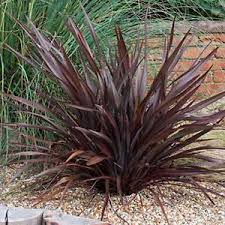 Phormium rubra 'Nana' Picture courtesy www.kazimingi.co.zaCoastal Flax, Giant New Zealand Flax, Swamp Flax, Harakeke (Phormium tenax)
Phormium rubra 'Nana' Picture courtesy www.kazimingi.co.zaCoastal Flax, Giant New Zealand Flax, Swamp Flax, Harakeke (Phormium tenax)
Coastal Flax is a fast growing evergreen, clump-forming perennial, native to New Zealand and Norfolk Island, and which can commonly be found growing wild in lowland swamps and intermittently flooded land. It forms a clump of erect, rigid, sword-shaped, bright green leaves and grows +-1.5 to 2.5m tall and +-1.5 to 2.5m wide. Leaf margins and midribs are narrowly edged with red-orange. Bronze and purple leaved varieties are available, with a number of cultivars featuring variegated leaves, striped or edged with green, cream, chocolate brown, pink, red, orange or purple. The flowers appear in summer, are dark red and held upright on a tall stalk above the foliage.
(Phormium tenax 'Atropurpureum')
'Atropurpureum' has strongly vertical burgundy-bronze leaves, and grows +-1.5 to 2m tall with an equal spread.
(Phormium tenax 'Lineata')
'Lineata' has wide, rigidly upright green leaves with narrow creamy stripes running vertically through the leaves. It grows +-2m tall with an equal spread.
(Phormium tenax 'Variegatum')
'Variegatum' has beautifully banded green and creamy yellow leaves. This rigidly upright grower can reach +- 1.2 to 1.8m tall with an equal spread.
(Phormium tenax 'Nana Variegatum’)
'Nana Variegatum’ is a lovely dwarf variety with green leaves, striped with white and yellow. It grows +- 80cm to 1m tall with an equal spread.
(Phormium tenax 'Rubra')
'Rubra' grows +-1 to 1.2m tall and +-75cm to 1m wide and produces narrow, arching, reddish-chocolate-brown leaves.
(Phormium tenax ‘Rubra Nana')
‘Rubra Nana' is a lovely dwarf variety which only grows +-40 to 60cm tall and 30 to 40cm wide; and produces gorgeous, narrow, reddish-chocolate-brown leaves.
(Phormium tenax ‘Baby Bronze’)
‘Baby Bronze’ has attractive bronze-brown to green leaves which arch over at the tips. It grows +-30cm tall and 30cm wide, but can double its size with maturity.
(Phormium tenax ‘Baby Green’)
‘Baby Green’ has green leaves with bronze edges which arch over at the tips. It grows +-30cm tall and 30cm wide, but can double its size with maturity.
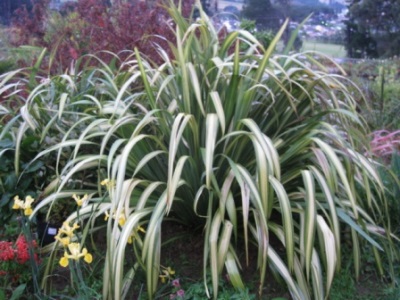 Phormium 'Yellow Waves' Picture courtesy www.steyns-nursery.co.zaMountain Flax, Wharariki (Phormium cookianum)
Phormium 'Yellow Waves' Picture courtesy www.steyns-nursery.co.zaMountain Flax, Wharariki (Phormium cookianum)
Mountain Flax is a fast growing, evergreen, clump-forming perennial native to New Zealand. It has two distinct geographic forms, one occurring in lowland parts of the North Island, and the other in the southern and mountainous areas of the South Island, as well as ranges in the North Island. In the Cook Strait area, both forms and intermediates can be found. It grows +-1.2 to 2m tall and 90cm to 1m wide, and has softer, shorter leaves than P. tenax, pruducing greenish flowers in summer, often with yellow or orange tones, held horizontally on an arching flower stalk up to 2m in height. Numerous forms of this species have been selected for cultivation and many beautiful cultivars are available to gardeners.
(Phormium cookianum ‘Flamingo’)
‘Flamingo’ has an upright, arching habit, and pink striped leaves which also display shades of orange, green and yellow. It grows +-60cm to 1m tall with an equal spread.
(Phormium cookianum ‘Yellow Wave’)
‘Yellow Wave’ has gracefully arching yellow leaves with green edges and grows +-70cm to 1m tall, but with maturity can reach 1.2 to 1.5m tall with an equal spread.
(Phormium cookianum ‘Cream Delight’)
‘Cream Delight’ has erect leaves with drooping tips and beautiful creamy yellow bands on the leaves. It grows +-50cm to 1m tall with an equal spread, but with maturity can reach 1.5m.
(Phormium cookianum ‘Pink Stripe’)
‘Pink Stripe’ is also sometimes called ‘Candy Stripe’ and has wide bronze-green (almost grey) leaves edged with pink. It grows +-1.5m tall and 1.3m wide, but with maturity can reach 2m tall with an equal or greater spread.
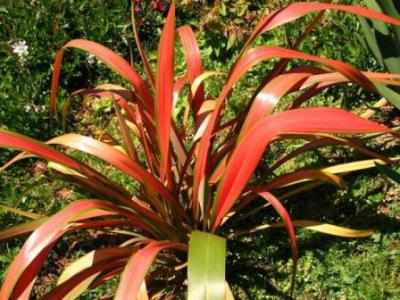 Phormium 'Jester' Picture courtesy www.steyns-nursery.co.zaGorgeous Phormium garden hybrids include:
Phormium 'Jester' Picture courtesy www.steyns-nursery.co.zaGorgeous Phormium garden hybrids include:
(Phormium hybrid ‘Dazzler’)
‘Dazzler’ is compact with a weeping form and dark purple arching leaves, heavily striped with red to pinkish-red. It grows +-75cm tall with an equal spread.
(Phormium hybrid ‘Jester’)
‘Jester’ has bright green foliage striped with a wide, hot-pink central band; and grows +-1m tall and 1m wide.
(Phormium hybrid ‘Apricot Queen’)
‘Apricot Queen’ has a beautiful upright-growth habit with yellow foliage edged in green; its leaves turn apricot with age and cold weather. This dwarf grows +- 80cm to 1m tall and 60cm to 1m wide.
(Phormium hybrid ‘Margaret Jones’)
‘Margaret Jones’ has gorgeous striped rose-red leaves with bronze edges; and grows +-60cm to 1m tall.
(Phormium hybrid ‘Parfait' var. Tango)
‘Parfait' var. Tango has truly beautiful foliage with green edges and shades of pink in the centre.
(Phormium hybrid 'Amazing Red')
'Amazing Red' has an upright growth habit and produces narrow dark reddish-brown leaves that curve downward at the tips. It grows +-80cm tall and 60cm wide.
(Phormium hybrid 'Chocolate' TM var. Jack Spratt)
'Chocolate' produces lovely narrow, soft chocolate-brown leaves; and grows +-40cm tall and 30cm wide.
(Phormium hybrid 'Dusky Chief')
'Dusky Chief' has an upright growth habit and striking maroon-red to purple. It grows +-1.2m tall and 80cm wide.
(Phormium hybrid 'Pink Panther')
'Pink Panther' has stunning red-pink leaves with deep red edges. It grows +-80cm tall and 50cm wide.
(Phormium hybrid 'Rainbow Maiden')
'Rainbow Maiden' has upright growing leaves which droop at the tips. The foliage has lovely rich salmon-pink centres and coral-red variegations. It grows +-90cm tall and 50cm wide.
(Phormium hybrid 'Rainbow Queen'
'Rainbow Queen' has broad upright growing leaves which droop at the tips. The foliage lovely is a lovely bronze-green with rose-red stripes. It grows +-1.2m tall and 80cm wide.
(Phormium hybrid 'Rainbow Sunrise')
'Rainbow Sunrise' has bronze foliage with red and pink variegations, tending to be pinker in the centre. It grows +-80cm tall and 50cm wide.
(Phormium hybrid 'Rosie Chameleon')
'Rosie Chameleon' has wine-red leaves with fine bronze shading in the centre and bronze edges. In autumn and winter the wine red leaves can change to yellow. It grows +-40cm tall and 30cm wide.
 Phormium nana 'Variegata' Picture courtesy www.kazimingi.co.zaUses:
Phormium nana 'Variegata' Picture courtesy www.kazimingi.co.zaUses:
Today their foliage is a favourite with florists; and the tall flowering stems with their bean-like fruits are great to use in dried floral arrangements.
Phormium tenax had many uses in traditional Māori society, with the split leaves being used to make sails, woven baskets, nets, cloaks, sandals, straps etc. but most of these have fallen into disuse and its primary use today is for the weaving of kete (flax baskets). A very high quality pliable fibre is obtained from the leaves of flax which is used in the manufacture of fine cloth and paper. The leaves can also be made into twine, but this is not very strong. The leaves are harvested in summer, scraped to remove the outer skin, and then soaked in water for 2 hours prior to cooking. The fibres are then cooked for 24 hours with lye and then beaten in a ball mill for 4 hours.
The roasted seed can be used as a coffee substitute, and healthy, edible nectar is obtained from the flowers. The leaf pulp, after the fibre has been removed, can be fermented to make alcohol. An edible gum is obtained from the leaves and is also used as paper glue. Brown dye is obtained from the flowers and terracotta coloured dye is obtained from the seedpods.
The roots can be crushed to make poultices for skin infections, and to produce a juice with disinfectant and laxative properties. The gum from the base of the leaves was used to ease pain and heal wounds, especially burns. The leaves themselves could be used as bandages and to secure broken bones.
In the Garden:
An excellent architectural specimen, New Zealand flax has a striking geometric shape and the hybrids have intriguingly coloured foliage. They are all wonderful for low maintenance flower and shrub borders, as well as in gravel or rock gardens, or at the edge of a lawn. Use them in featured mass plantings, along roadsides, and in parks. They are also suitable to plant near buildings and in courtyards; and the smaller varieties grow beautifully in pots.
 Phormium rubra Picture courtesy www.kazimingi.co.zaCultivation:
Phormium rubra Picture courtesy www.kazimingi.co.zaCultivation:
Phormium tenax and cookianum are hardy evergreens which tolerate heat, drought, frost, and temperatures as low as -5°C once established. They grow well throughout South Africa and are excellent coastal plants, but in humid regions require very well-drained soil. Although they are drought hardy, the plants look at their best if they are watered regularly during dry spells; this is especially important in the very hot and dry regions of the country. P. tenax will also grow in seasonally dry or wet soil.
Flaxes can be planted in full sun or semi-shade, and although they prefer a light (sandy) to medium (loamy) soil; will adapt to most well-drained garden soils, and even heavy (clay) soils with good drainage. They tolerate acid, as well as neutral and basic (alkaline) soils and can be grown in saline (salty) soils.
The hybrids with their colourful leaves are usually less tolerant of extremely hot or cold temperatures, prolonged dry conditions and heavy clay soil, so check with your local garden centre for the best varieties for your region. During hot and dry conditions sunburn can occur on the cultivars; but especially on those with weeping leaves, so it would be wise to use these cultivars in bright shade and where there is protection from the fierce midday sun. Cold temperatures are also likely to scald the leaves of these plants, and in extremely cold gardens they will need protection in winter, or they may be planted in containers which can be moved to a sheltered spot. These hybrids are nearly as drought resistant as the species, but look at their best in the garden if watered moderately during long dry spells. The upright growing cultivars are less affected by these extremes in temperature and drought.
Remove dead or damaged leaves as required, and divide and split large specimens in spring, if necessary. The colourful leaf forms of some of the beautiful hybrid flaxes have a tendency to revert back to a green or bronze colour; so whenever you notice a shoot with an unwanted colour, cut it out immediately, right at the base of the plant. With some of the hybrids the new foliage is the showiest, and some gardeners prefer to remove most, or all of the older leaves as the new ones emerge.
When planting flax, ensure that the crown or base of the plant is not below soil level. Use a slow release fertiliser in spring if required.
Propagation:
Flax can be propagated from seed or by dividing off small fans of leaves and planting them directly in the soil.
 Pests & Diseases:
Pests & Diseases:
Phormium plants suffer from few maladies, but watch out for mealy bugs, which can be controlled through sprays; and snails and slugs that often use the underside of the leaves for an abode can be easily picked off or poisoned.
Warning:
The blades of the plant contain cucurbitacins, which are poisonous to some animals, and some of them are among the bitterest tastes to humans.
Flax is an invasive species in some of the Pacific islands and in Australia.


